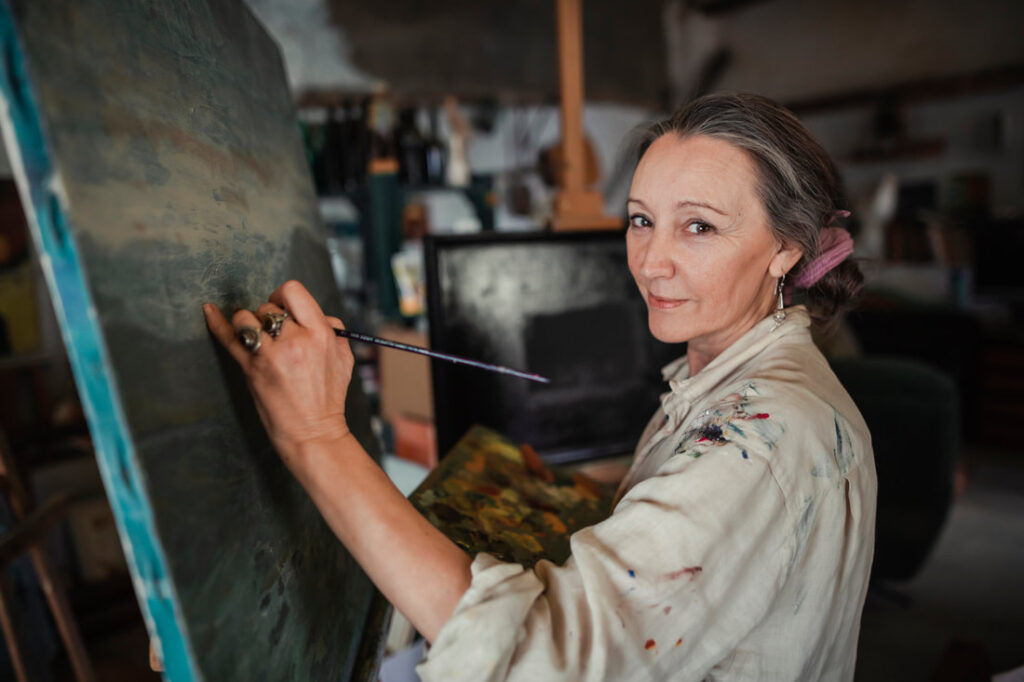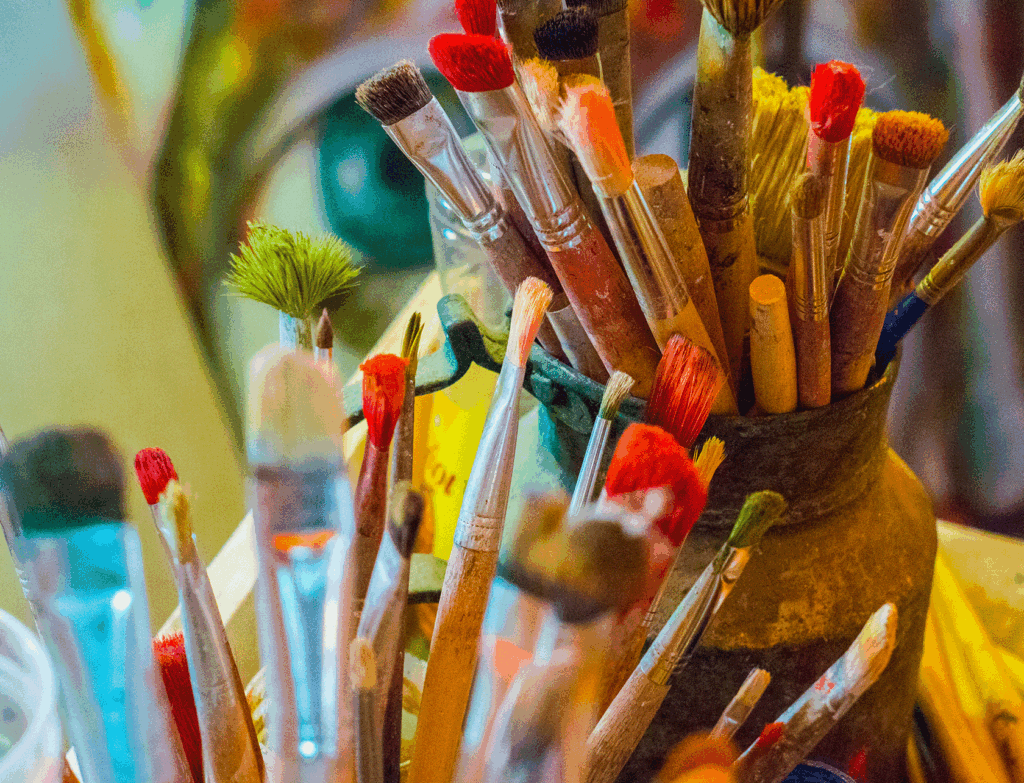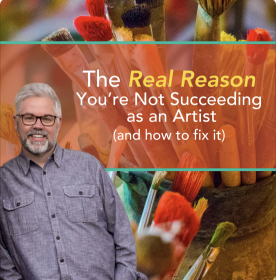
For many visual artists nearing or in retirement, the dream of turning their art hobby into a profitable business is both exciting and daunting. After decades of balancing careers, family, and responsibilities, this season of life presents an opportunity to focus on their creative passion. However, it also comes with its own unique set of challenges that can sidetrack or stop them from realizing their dream. In this article, we’ll explore the top struggles retired or near-retirement hobbyist artists face and offer practical solutions to overcome them. I’ve mentored hundreds of artists in this season of life over the years and trust me, there is hope!
1. Family Obligations That Take Up Their Time
Retirement often brings the joy of spending more time with family, but it can also lead to unexpected commitments. Many retired artists find themselves taking on the role of caregiver for aging parents, supporting adult children, or helping to raise grandchildren. These responsibilities, while rewarding, can limit the time and energy available to focus on growing an art business.
Solution: Set Boundaries and Prioritize Self-Care It’s important to recognize that pursuing your art business is a valid and valuable use of your time. Setting clear boundaries and communicating with family about your commitment to your art can help carve out dedicated time for your creative work. Consider establishing a schedule that includes regular studio hours, and let your loved ones know when you’ll be available for family activities. Prioritizing self-care, including rest and relaxation, will also ensure that you have the energy and focus needed to manage both family obligations and your business.
2. Health Problems (Their Own and Family Members’)
Health issues can be a significant barrier for artists who want to build a business in retirement. Whether it’s their own health challenges or those of family members, managing chronic conditions or sudden health crises can disrupt plans, reduce productivity, and drain energy. This can be particularly frustrating when trying to establish a consistent creative routine or meet the demands of running a business.
Solution: Adapt Your Workflow and Seek Support
Health challenges don’t have to mean giving up on your dream. Instead, consider adapting your workflow to suit your physical needs. For instance, if you have limited mobility, explore setting up a comfortable, accessible home studio. Break down tasks into manageable chunks and take regular breaks to avoid overexertion. If you’re caring for a loved one, look for local support services, such as respite care, to give yourself some time to focus on your art. Additionally, online resources and communities can provide inspiration and encouragement, helping you stay connected and motivated even when physical limitations make in-person events difficult.
3. Tech Challenges of Doing Business in an Online World
The online world has opened up incredible opportunities for artists to reach global audiences, but it can also be intimidating for those who aren’t tech-savvy. Setting up a website, managing social media, and navigating e-commerce platforms can feel overwhelming, especially for retired artists who may not have had much exposure to digital technology during their careers. This tech barrier can be a major roadblock to building a profitable art business.
Solution: Start Small and Learn the Basics
Overcoming tech challenges starts with learning the basics. Start by creating a simple website or online portfolio that showcases your work and includes an easy way for customers to contact you. There are user-friendly platforms, like Wix or Squarespace, designed for beginners. You can also take advantage of online tutorials, workshops, and courses that teach essential digital marketing skills, such as social media management, e-commerce, and search engine optimization (SEO). If managing the tech side of things still feels daunting, consider hiring a freelance professional to help set up your online presence so you can focus more on creating art.
4. Lack of Energy and Focus to Run a Growing Business
Running a business requires consistent energy, focus, and a strategic mindset. For artists who are retired or nearing retirement, the physical and mental stamina needed to manage a growing business can sometimes feel like a stretch. They may have the passion and skills, but find it difficult to maintain the drive required to handle marketing, sales, production, and other aspects of the business.
Solution: Create a Sustainable Business Model
To maintain energy and avoid burnout, it’s essential to build a business model that aligns with your current lifestyle and energy levels. Consider how much time you want to dedicate to your art each week, and design your business around that. For example, you might choose to create smaller, limited-edition series rather than mass-producing pieces. Outsourcing certain tasks, like accounting or order fulfillment, can free up more time for creative work. Streamline your operations by using systems and tools that automate repetitive tasks, allowing you to focus on the aspects of your business that you enjoy most. The key is to find a pace that feels sustainable so you can continue to enjoy your creative journey without feeling overwhelmed.
5. Difficulty Knowing How Big a Business They Want in This Season of Life
Many retired artists had big dreams earlier in life, envisioning large studios, bustling art shows, or a prominent gallery presence. However, their current season of life might not support those same ambitions due to changes in time, energy, and financial resources. Figuring out how to scale their business in a way that’s both profitable and realistic can be a major source of frustration.
Solution: Reassess and Redefine Your Business Goals
It’s okay for your goals to change. Take time to reflect on what you truly want from your art business in this season of life. Ask yourself: Do you want to pursue art full-time or keep it as a side business? Are you more interested in local markets, online sales, or exclusive commissions? Do you prefer one-on-one client interactions, or would you rather sell through a gallery or online store? By defining what success looks like for you now, you can create a business plan that aligns with your current reality. Smaller, more focused goals can be just as rewarding and financially viable as larger-scale ambitions, especially when they allow you to work at a comfortable pace.
6. Balancing Yesterday’s Dreams with Today’s Reality
For many near-retirement or retired artists, the desire to finally pursue their long-held dreams of making art full-time can clash with the realities of this stage of life. Maybe they’ve always imagined a bustling studio, but now they don’t have the energy to handle a high-volume business. Perhaps they’ve envisioned traveling to art shows around the country, but financial constraints make it difficult. Balancing these “yesterday’s dreams” with the realities of today can be disheartening.
Solution: Embrace Flexibility and Find New Ways to Fulfill Old Dreams
Instead of letting old dreams become sources of frustration, consider how you can adapt them to your current situation. For example, if you love the idea of a busy studio but can’t manage it alone, consider partnering with other local artists to share space and resources. If traveling to shows isn’t feasible, explore virtual art shows and online exhibitions that allow you to reach new audiences from the comfort of your home. The key is to be flexible and open-minded, finding new ways to bring your dreams to life while respecting your current needs and capabilities.
Don’t Let Challenges Stop You from Pursuing Your Passion
Turning your art hobby into a profitable business later in life is an incredibly rewarding pursuit, but it’s not without its challenges. From family obligations to tech barriers, health issues, and the struggle to find balance, there are many factors that can sidetrack your dreams. However, these challenges don’t have to be roadblocks; with the right strategies and mindset, you can navigate them successfully.
If you’re ready to take your art career to the next level and want guidance from someone who understands the challenges you face, consider joining the Created to Thrive Artist Mentoring Program. It’s the premier online community for artists who are Christians, designed to help you grow your art business, spiritual life, and creative practice from a faith-based perspective. Whether you’re struggling with balancing your time, building confidence, or navigating the tech side of the business, this program offers the support, tools, and community you need to thrive.
Ready to get started? Visit www.www.matttommeymentoring.com/artmentor and take the first step towards building a successful, fulfilling art business today!



Leave a Reply